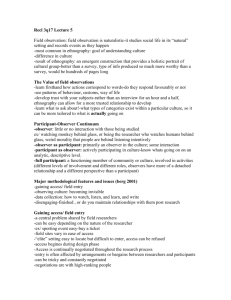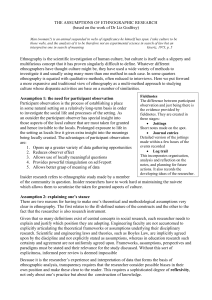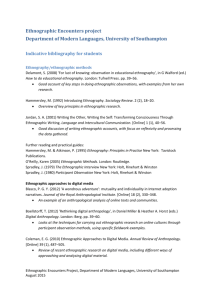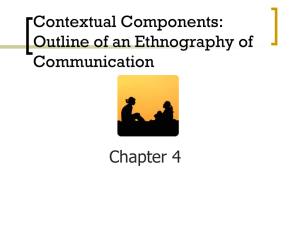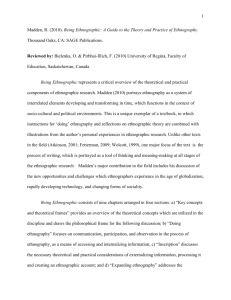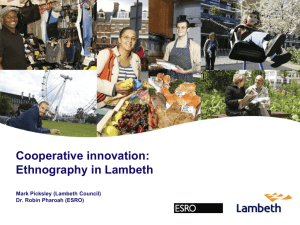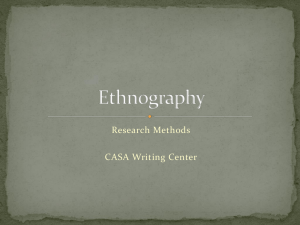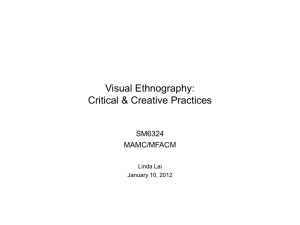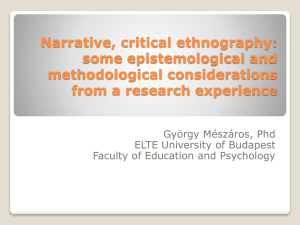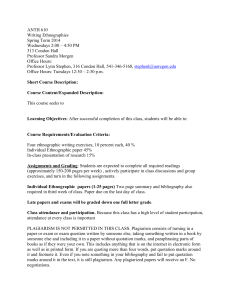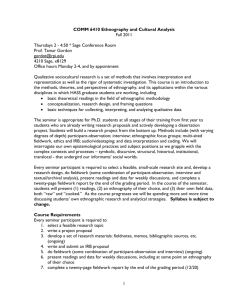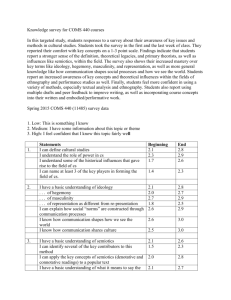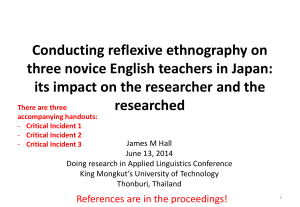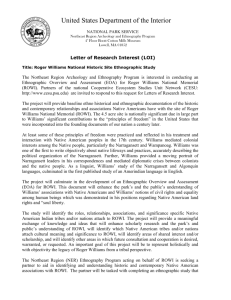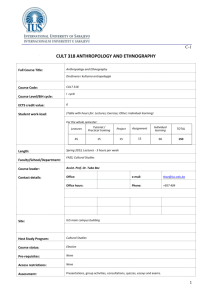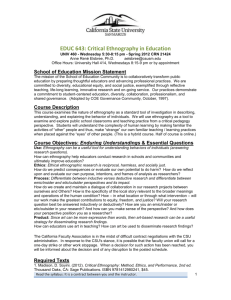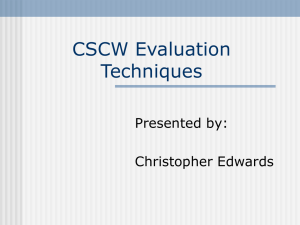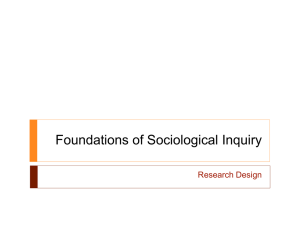IS8004(M) * Seminar 6 - Department of Information Systems
advertisement
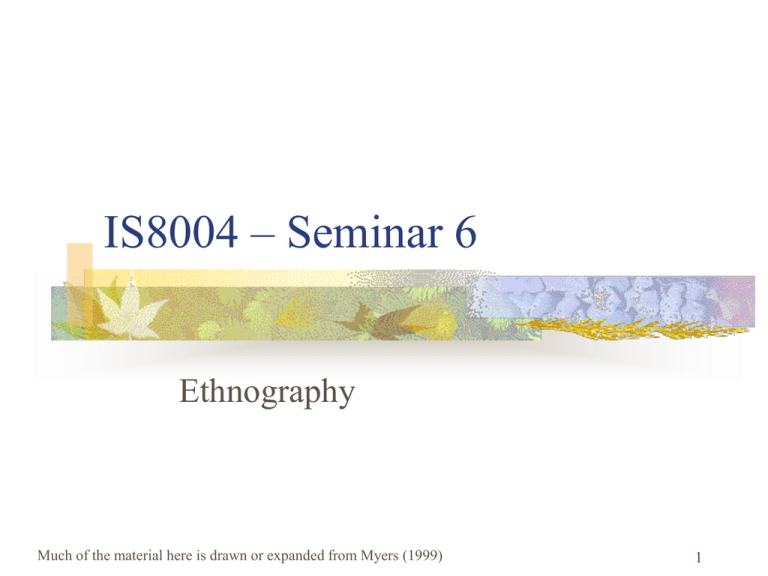
IS8004 – Seminar 6 Ethnography Much of the material here is drawn or expanded from Myers (1999) 1 Introduction “Ethnographic research is one of the most indepth research methods possible” (Myers, 1999) The researcher is embedded at a research site for a long time Seeing and hearing what they say and do Obtaining a deep understanding of the organisation and its people and work context. Ethnographic research can provide researchers with rich & detailed insights into the roles that information systems play 2 Topics Definition Benefits and Limitations Types of ethnography Practical guidance How to write up ethnographic studies Evaluation of ethnographic studies 3 Definition & Distinction Ethnographic research usually requires the researcher to spend a considerable period of time in the “field”. It is critical that the researcher engages in detailed, observational evidence gathering. This includes ‘participant observation’ and ‘informal social contact’. Like case studies, ethnographies also include interview data 4 Benefits 1 Depth. No other method allows the researcher to gain such depth or intensity in studying a phenomenon. Intimacy. By staying in ‘the field’ for an extended amount of time, the researcher can become invisible to the research subjects and so gain a degree of intimacy of understanding of the people, their work, routines, frustrations, politics, competing, relationships and dangers in the day-to-day organisational context. 5 Benefits 2 Challenges to accepted knowledge. When you are deep in the context, you start to question what you already know – if there is contradictory evidence An ethnography permits a ‘deeper-thanusual’ understanding of the problem – and so can lead to a new appreciation of that problem. 6 For Example Hughes et al. (1992) found that ‘good design principles’ were actually not good in all contexts Orlikowski (1991) found that IT contributes to intensifying control in some contexts These findings were unexpected by the researchers and the prior literature. 7 Limitations 1 Time It takes a long time to complete an ethnographic investigation Including data collection, analysis and writing There is enough time in a PhD, if you start early! Some of the most influential and insightful works on IT and organisations have come from ethnographic studies (e.g. Zuboff, 1988). 8 Limitations 2 Depth & Breadth It is too deep. You don’t get much sense of the world beyond the context It is hard to generalise to other contexts However, as with single case studies, you can generalise to theory Also, as more ethnographic studies are completed, so they can be compared 9 Types of Ethnography 1 Holistic Go native and live like the locals. Become a sponge that absorbs the local knowledge Semiotic Empathy is not needed. Instead, seek out the symbols (words, images, behaviours, institutions, arrangements, routines) and understand their relationships with each other and the context. Identify the ‘webs of significance’ in these contexts (Geertz). 10 Types of Ethnography 2 Cyber (Ward, 1999) Traditional ethnographic methods are designed for physical communities, but what about the virtual world? Cyber-ethnography involves a study of online interactions The researcher has to be embedded online as a member of the community The researcher engages in a dialogue with the online subjects – who ‘talk back’ The online subjects are much more involved than in a traditional ethnography 11 Practical Guidance 1 (on doing Ethnography) Field notes Participant observations, thoughts, reflections, interviews, feelings and questions Write them up regularly (within a few hours) – don’t rely on your memory, which is quickly swamped Keep them up to date and keep them detailed Something might seem very strange or odd at the beginning – yet later it makes a lot of sense when you know more. 12 Practical Guidance 2 (on doing Ethnography) Reflect! Review what you wrote, or thought Comment on your reflections – explicitly Much of the data is observational and personal On your ideas, impressions, feelings, thoughts But if you don’t codify it, you may lose it Develop a way to manage data Indexes, classification schemes, summaries, etc. 13 Writing Up Ethnographic Research Again, there are many styles Realism Impressionism Confessionism Narrative Ethnography means writing about your data and the people/context that it represents. To do this you have to have a personal style. 14 A Book! Yes, honestly, to do justice to the huge volume and richness of data you collect, a book is the only way to represent all the detail faithfully Zuboff (1988) In the Age of the Smart Machine Descola (1996) The Spears of Twilight 15 Journal Articles 1 Yes, that’s right, most of us need to publish journal articles, not books What you have to do is to treat each article as a part of the whole story This means that a single ethnographic study can produce multiple journal articles The same story can be told from different perspectives 16 Journal Articles 2 Each (of several) journal article needs to be complete, so it is better if it addresses only a single question or area of contribution It needs to present a description with persuasive evidence that will be interesting for the audience Recall the guidance for writing up case studies – very similar Indeed, each article is one case study, one aspect of an ethnography 17 Journal Articles 3 Another way to think of it is to compare it to a PhD thesis From a ‘good’ thesis, you should be able to produce multiple journal articles Each article offers a different view or slice of the story or data Each offers a different contribution, even as each may rely on the same background and the same set of theories. 18 Evaluating Ethnography 1 Contribution Rich Insight? Is it persuasive, clear, theory-linked, new? The reader must gain detailed insights into the phenomenon Does the paper contradict the status quo or organisational policy? Evidence Demonstrate how much data you collected. Cite this evidence in its social context. Reveal hidden agendas, disagreements, frustrations,… 19 Evaluating Ethnography 2 Methods You need to document what you did very carefully – so that others can judge if your work was conducted according to appropriate standards Your readers will be both experts and novices A novice should learn ‘how to do’ ethnography as much as appreciate the insights from your story 20 Opportunities Any organisational context that involves technology is a potential opportunity for an ethnographic investigation that can reveal new insights and contradictory findings that will reinform our knowledge, challenge existing theoretical perspectives and so make a convincing contribution You just have to be brave enough to try! 21 References Descola, P. (1996) The Spears of Twilight, The Free Press, New York. Geertz, C. (1973) The Interpretation of Cultures. New York: Basic Books. Hughes, J. A., Randall, D. and Shapiro, D. (1992) Faltering from Ethnography to Design. ACM 1992 Conference on Computer-Supported Cooperative Work: Sharing Perspectives, New York, 115-123. Klein, H. K. and M. D. Myers (1999) A Set of Principles for Conducting and Evaluating Interpretive Field Studies in Information Systems, MIS Quarterly 23, 1, 67-93. Myers, M.D. (1999) Investigating Information Systems with Ethnographic Research, Communications of the AIS, 2, 23, 1-20. Orlikowski, W. J. (1991) Integrated Information Environment or Matrix of Control? The Contradictory Implications of Information Technology, Accounting, Management and Information Technologies 1, 1, 9-42. Van Maanen, J. (1988) Tales of the Field: On Writing Ethnography. Chicago: University of Chicago Press. Ward, K.J. (1999) Cyber-ethnography and the emergence of the virtually new community, Journal of Information Technology, 14, 1, 95-105. Zuboff, S. (1988) In the Age of the Smart Machine. New York: Basic Books. 22
